Precipitation Changes and Future Trend Predictions in Typical Basin of the Loess Plateau, China
Abstract
1. Introduction
2. Materials and Methods
2.1. Study Area
2.2. Data Sources
2.3. Methodology for Calculating Ecological Building Potential
- 1.
- Analysis of Precipitation Change Characteristics
- 2.
- Future Precipitation Change Patterns and Trends
3. Results and Analyses
3.1. Intra-Annual Variation Characteristics of Precipitation
3.2. Interannual Variation Characteristics of Precipitation
3.3. Extreme Rainfall Analysis
3.4. Future Variation Characteristics of Precipitation
4. Discussion
4.1. Causes of Recent Changes in Precipitation
4.2. Causes of Future Changes in Precipitation
4.3. Discussion of Uncertainty
5. Conclusions
- (1) Precipitation in the Kuye River Basin is primarily concentrated during the summer months (July–August) and the flood season (May–October). These two months account for 49.23% of the annual precipitation, while the flood season contributes a substantial 88.16%. In contrast, winter months (December–January) experience the least precipitation, comprising only 1.07% of the annual total, reflecting the pronounced influence of the continental monsoon climate.
- (2) The multi-year average precipitation is 445 mm, characterized by relatively low interannual variability (coefficient of variation, Cv = 0.27), and exhibits an overall fluctuating upward trend. Notably, the year 2006 marked a regime shift in precipitation, after which a significant increase was observed, largely driven by natural phenomena (e.g., El Niño) and anthropogenic activities (e.g., soil and water conservation efforts).
- (3) From 2023 to 2052, the multi-year average precipitation is projected to reach 524.69 mm, indicating a general upward trend. The coefficient of variation (Cv) for interannual variability is expected to decrease to 0.24, suggesting limited fluctuations. The year 2043 is identified as a potential point for a future precipitation regime shift, beyond which an increase in precipitation is anticipated. Spatially, precipitation is expected to exhibit a pattern of decreasing amounts in the northwest and increasing amounts in the southeast.
- (4) The changes in precipitation are influenced by multiple factors, including climate change scenarios, the stability of the basin’s hydrological characteristics, topography, and anthropogenic activities such as soil and water conservation efforts. Among these, climatic factors are identified as the predominant influence, serving as the key driver of alterations in precipitation patterns throughout the basin. Moreover, human activities, particularly soil and water conservation measures, have a positive impact on enhancing local microclimates within the basin.
Author Contributions
Funding
Institutional Review Board Statement
Informed Consent Statement
Data Availability Statement
Acknowledgments
Conflicts of Interest
References
- Zuo, H.; Lv, S.; Hu, Y. Variations Trend of Yearly Mean Air Temperature and Precipitation in China in the Last 50 Years. Plateau Meteorol. 2004, 2, 238–244. (In Chinese) [Google Scholar]
- Hu, J. Working Together to Address the Challenges of Climate Change—Remarks at the Opening Ceremony of the United Nations Climate Change Summit. Resour. Habitant Environ. 2009, 20, 13–15. [Google Scholar] [CrossRef]
- Li, G.; Harrison, S.; Bartlein, P.; Izumi, K.; Prentice, I. Precipitation scaling with temperature in warm and cold climates: An analysis of CMIP5 simulations. Geophys. Res. Lett. 2013, 40, 4018–4024. [Google Scholar] [CrossRef]
- Li, Q.; Yang, M.; Wan, G.; Wang, X. Spatial and temporal precipitation variability in the source region of the Yellow River. Environ. Earth Sci. 2016, 75, 594. [Google Scholar] [CrossRef]
- Zeng, Q. Mathematical problems in prediction and controlling of climate and environmental systems. Clim. Environ. Res. 2002, 7, 1–6. [Google Scholar] [CrossRef]
- Diffenbaugh, N.; Scherer, M. Using climate impacts indicators to evaluate climate model ensembles: Temperature suitability of premium winegrape cultivation in the United States. Clim. Dyn. 2013, 40, 709–729. [Google Scholar] [CrossRef]
- Plaga, L.; Bertsch, V. Methods for assessing climate uncertainty in energy system models—A systematic literature review. Appl. Energy 2023, 331, 120384. [Google Scholar] [CrossRef]
- Zhou, T.; Zou, L.; Wu, B.; Jin, C.; Song, F.; Chen, X.; Zhang, L. Development of earth/climate system models in China: A review from the Coupled Model Intercomparison Project perspective. J. Meteorol. Res. 2014, 28, 762–779. [Google Scholar] [CrossRef]
- Stevens, B. A Perspective on the Future of CMIP. AGU Adv. 2024, 5, e2023AV001086. [Google Scholar] [CrossRef]
- Klein, C.; Jackson, L.; Parker, D.; Marsham, J.; Taylor, C.; Rowell, D.; Guichard, F.; Vischel, T.; Famien, A.; Diedhiou, A. Combining CMIP data with a regional convection-permitting model and observations to project extreme rainfall under climate change. Environ. Res. Lett. 2021, 16, 104023. [Google Scholar] [CrossRef]
- Guo, X.; Xun, X.; Liu, D.; Zhang, M.; Chen, H.; Bao, F. Impacts of climate change and human activities on vegetation cover during the growing season in the Kuye River Basin. Trans. Chin. Soc. Agric. Eng. 2025, 41, 304–313. [Google Scholar] [CrossRef]
- Mann, H.B. Nonparametric test against trend. Econom. J. Econom. Soc. 1945, 13, 245–259. [Google Scholar] [CrossRef]
- Pettitt, A.N. A Non-Parametric Approach to the Change-Point Problem. J. R. Stat. Soc. 1979, 28, 126–135. [Google Scholar] [CrossRef]
- Pettitt, A.N. A simple cumulative sum type statistic for the change-point problem with zero-one observations. Biometrika 1980, 67, 79–84. [Google Scholar] [CrossRef]
- Ding, J. Statistical extrapolation of disturbance points in flood time series. Eng. J. Wuhan Univ. 1986, 5, 38–43. (In Chinese) [Google Scholar]
- Fu, C.; Wang, Q. The definition and detection of the abrupt climate change. Sci. Atmos. Sin. 1992, 16, 482–492. (In Chinese) [Google Scholar]
- Feng, Y.; Zhu, J. Analysis on Runoff Change and the Driving Force of the Liaohe River Basin Based on Morlet Wavelet. Res. Soil Water Conserv. 2019, 26, 208–215. (In Chinese) [Google Scholar]
- Hui, K.L. Monsoonal Precipitation in a Model Hierarchy: Impact of Continental Geometry and Global Warming. Ph.D. Thesis, California Institute of Technology, Pasadena, CA, USA, 2022. [Google Scholar] [CrossRef]
- Ma, Q.; Li, Z.; Lei, H.; Chen, Z.; Liu, J.; Wang, S.; Su, T.; Feng, G. Interannual Variability of Extreme Precipitation during the Boreal Summer over Northwest China. Remote Sens. 2023, 15, 785. [Google Scholar] [CrossRef]
- Alexander, L.; Uotila, P.; Nicholls, N. Influence of sea surface temperature variability on global temperature and precipitation extremes. J. Geophys. Res. 2009, 114, D18116. [Google Scholar] [CrossRef]
- Krashevska, V.; Stiegler, C.; June, T.; Widyastuti, R.; Knohl, A.; Scheu, S.; Potapov, A. Land-use change shifts and magnifies seasonal variations of the decomposer system in lowland tropical landscapes. Ecol. Evol. 2022, 12, e9020. [Google Scholar] [CrossRef]
- Wang, J.; Feng, J.; Yan, Z.; Hu, Y.; Jia, G. Nested high-resolution modeling of the impact of urbanization on regional climate in three vast urban agglomerations in China. J. Geophys. Res. Atmos. 2012, 117, D21103. [Google Scholar] [CrossRef]
- Nguyen, Q.; Ngo, H.; Vu, M. Climate change induced the altering in precipitation characteristics across the rice cultivation paddies of Vietnam. Mausam 2024, 75, 659–668. [Google Scholar] [CrossRef]
- Zheng, L.; Zhu, L.; Wang, W.; Guo, L.; Chen, B. Land Subsidence Related to Coal Mining in China Revealed by L-Band InSAR Analysis. Int. J. Environ. Res. Public Health 2020, 17, 1170. [Google Scholar] [CrossRef] [PubMed]
- Zhou, S.; Liu, L.; Shi, F. Making Soil and Water Conservation Regionalization with Quantitative Analysis of Multiple Factors—Taking the Kuyehe and Gushanchuan Watersheds as An Example. J. Soil Water Conserv. 1993, 7, 35–45. (In Chinese) [Google Scholar]
- Yuan, F. Hydrological Processes Modeling Considering the Effect of Vegetation. Ph.D. Dissertation, Hohai University, Nanjing, China, 2006. [Google Scholar]
- Xu, X.; Yan, P.; Liang, X. The Water Resources Effect of Typical Soil-saving Dams in Wudinghe River Drainage Basin—A Case Study in Xindian, Jiuyuan and Peijiamao Ditch. J. Arid Land Resour. Environ. 2008, 22, 78–83. (In Chinese) [Google Scholar]
- Song, W.; Wang, Q. CP El Nino and PDO Variability Affect Summer Precipitation over East China. Adv. Meteorol. 2020, 2020, 2747194. [Google Scholar] [CrossRef]
- Tsvetkova, O.V. Uncertainty in Climatic Change Impacts on Multiscale Watershed Systems. Ph.D. Dissertation, University of Massachusetts Amherst, Amherst, MA, USA, 2013. [Google Scholar] [CrossRef]
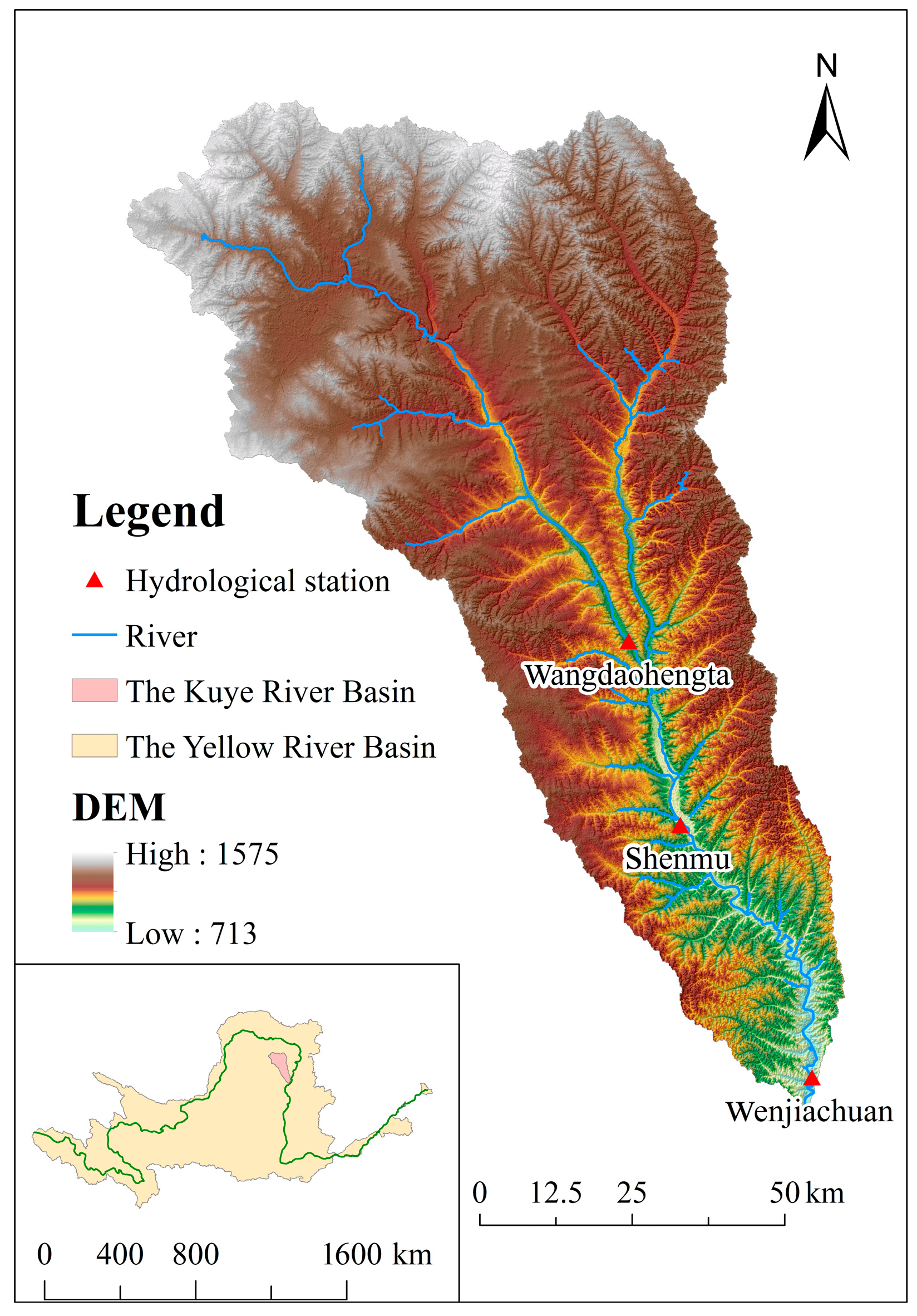
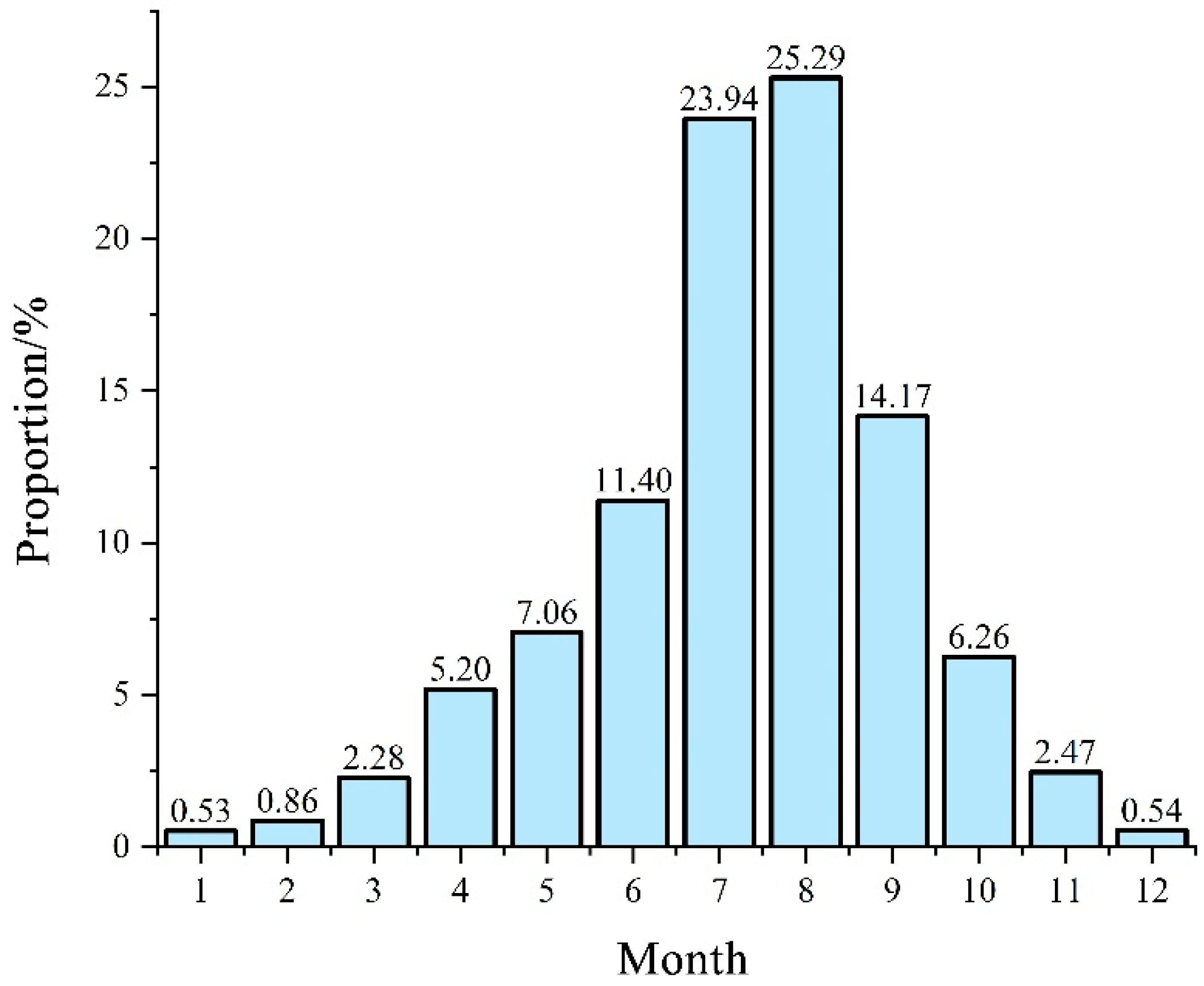
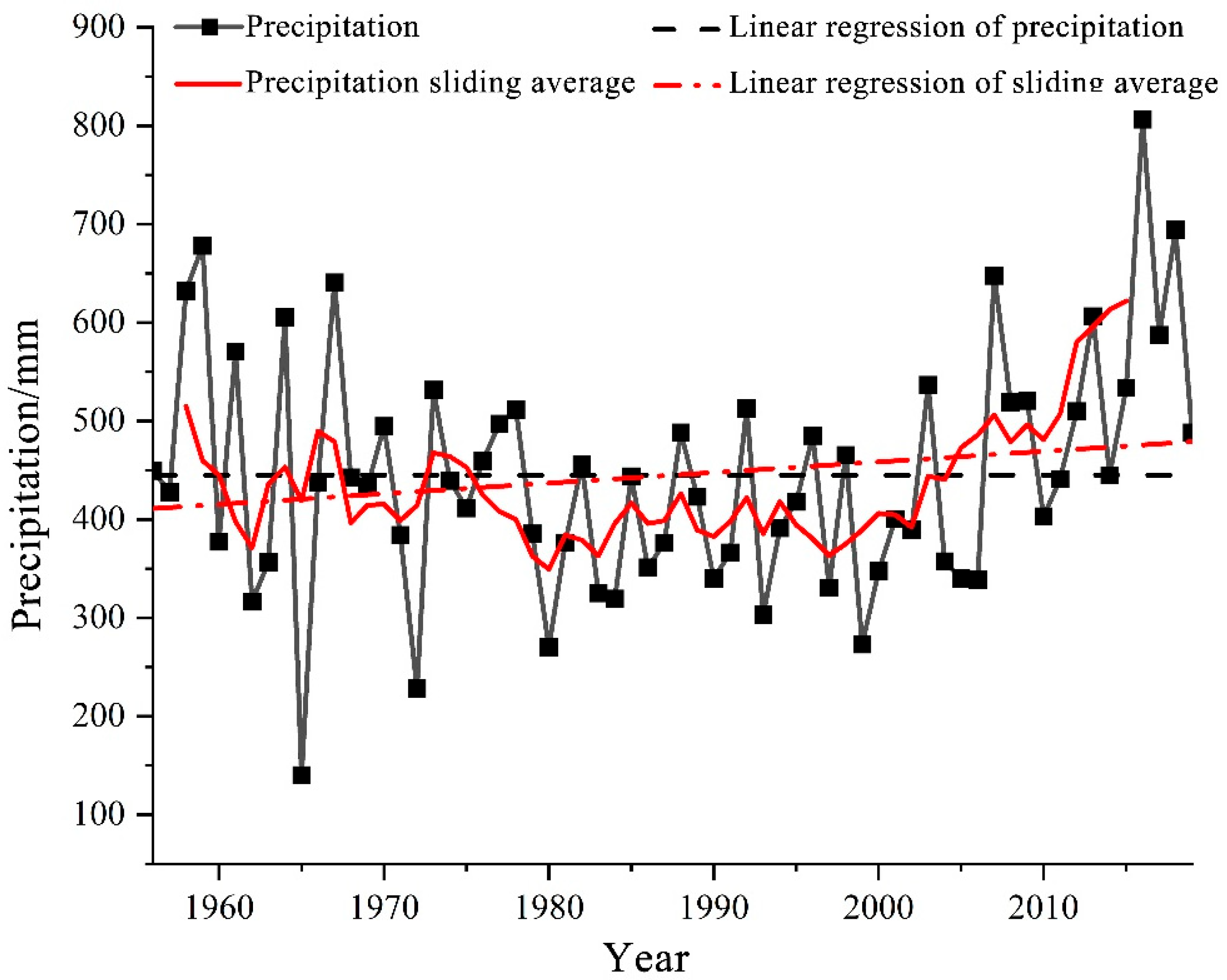
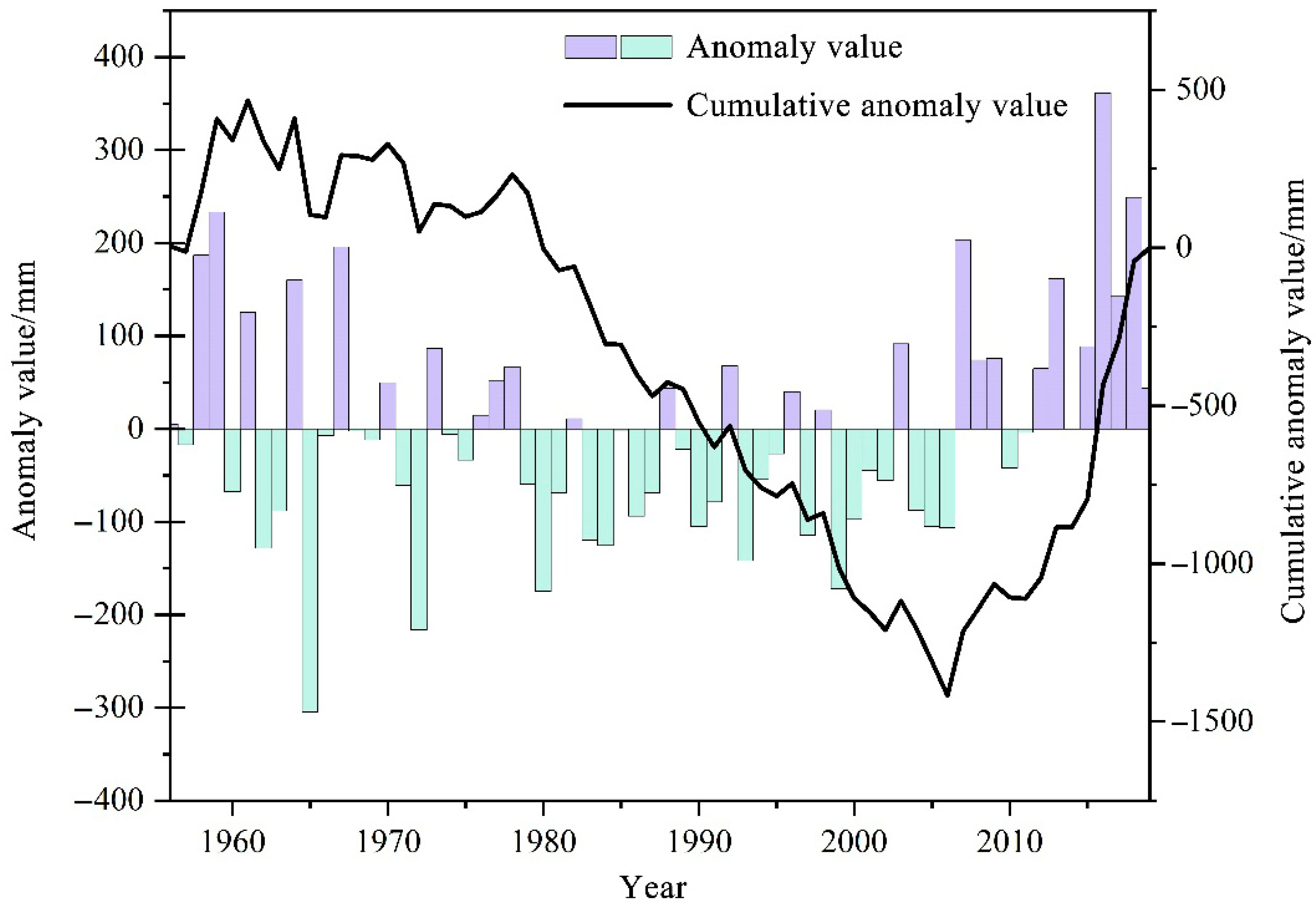
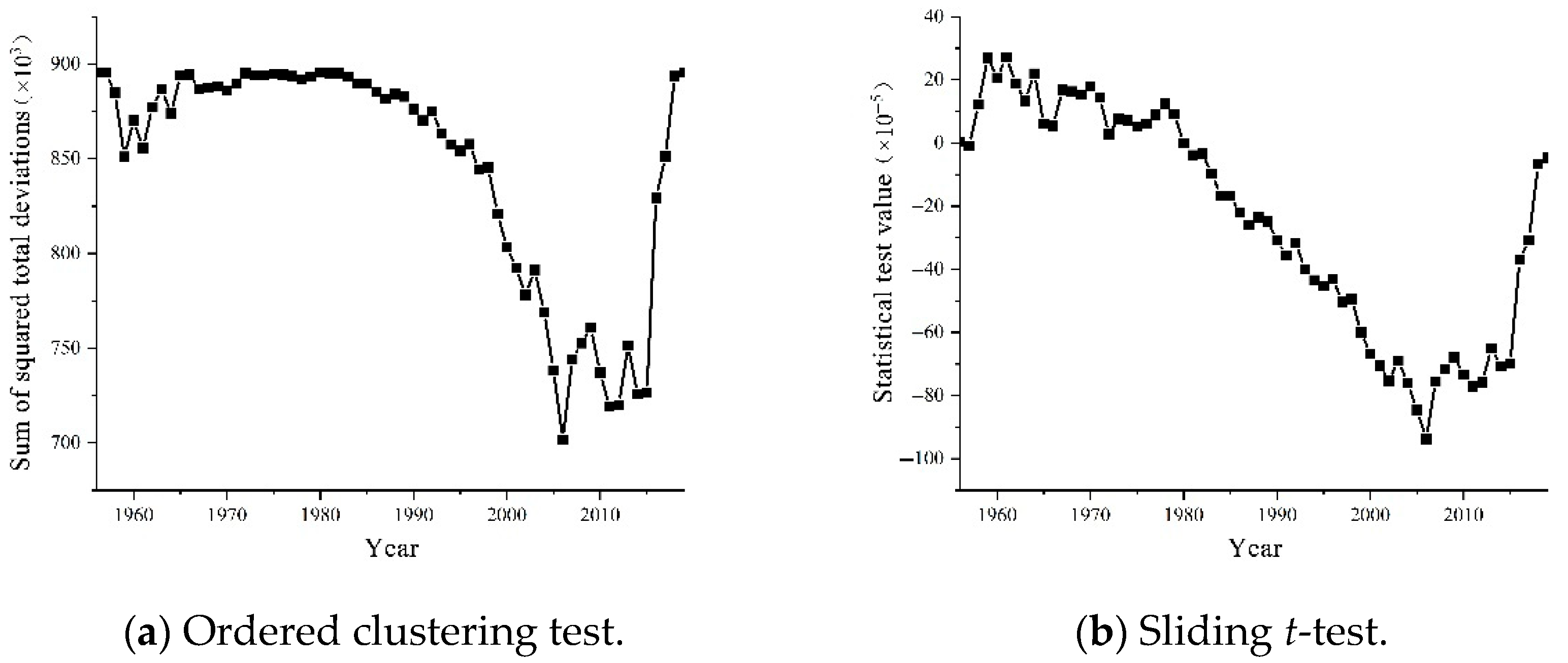
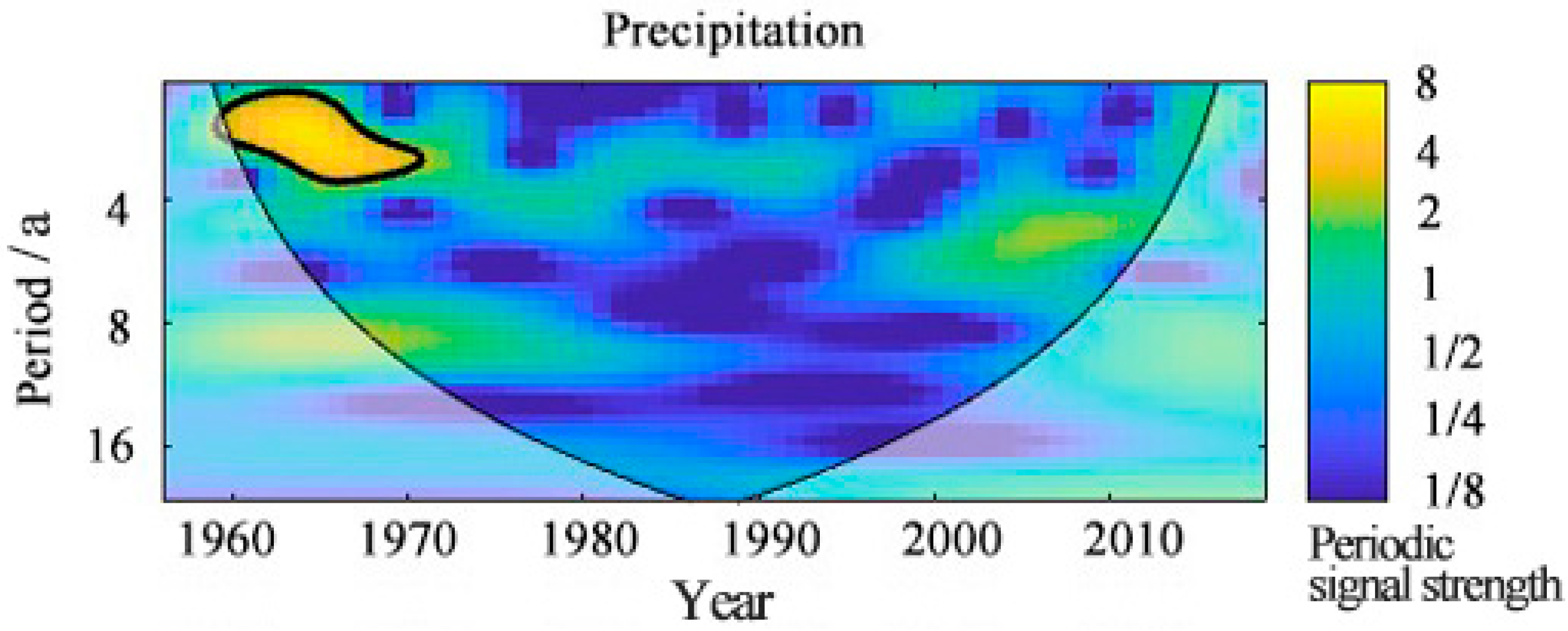
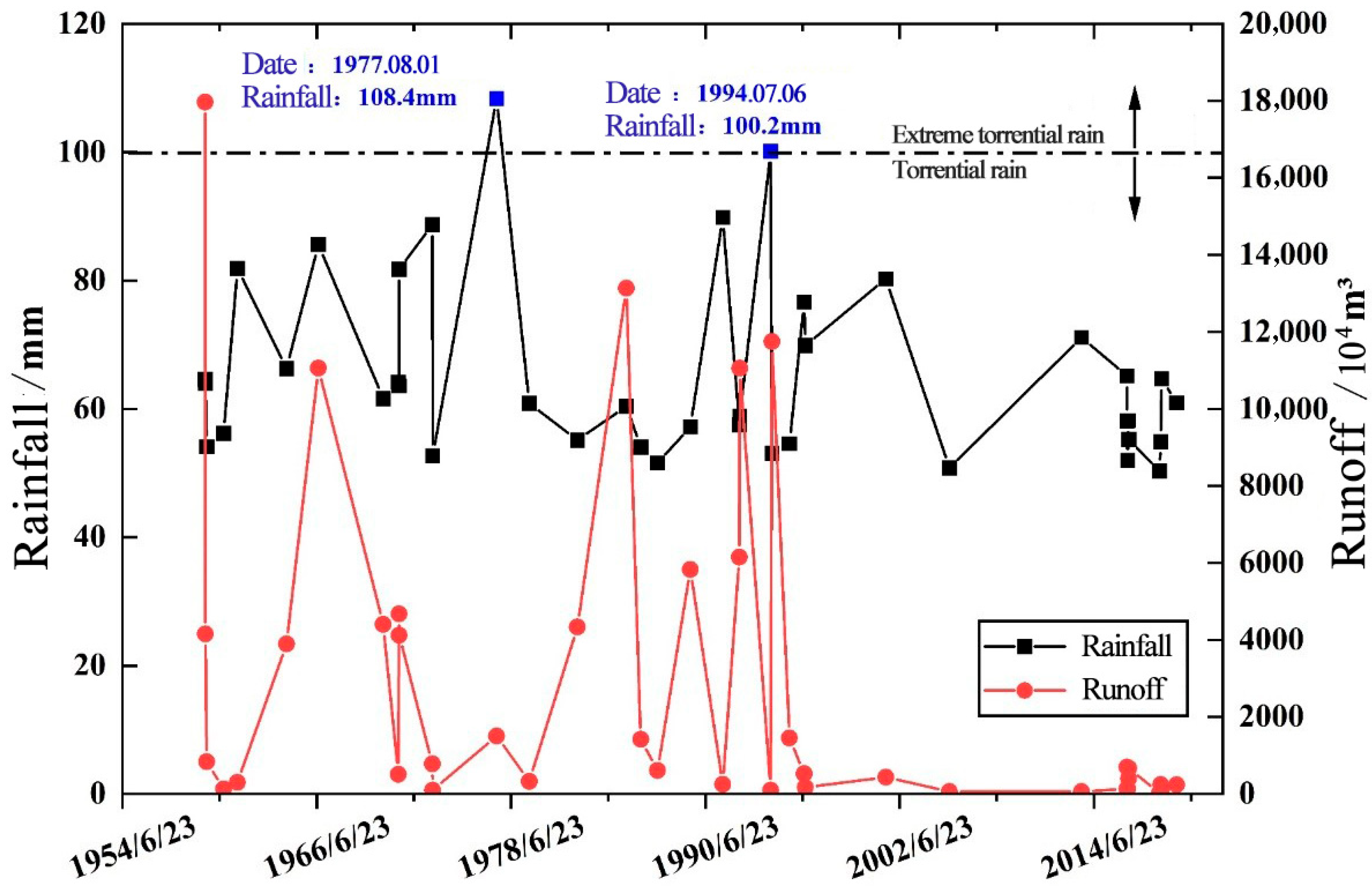
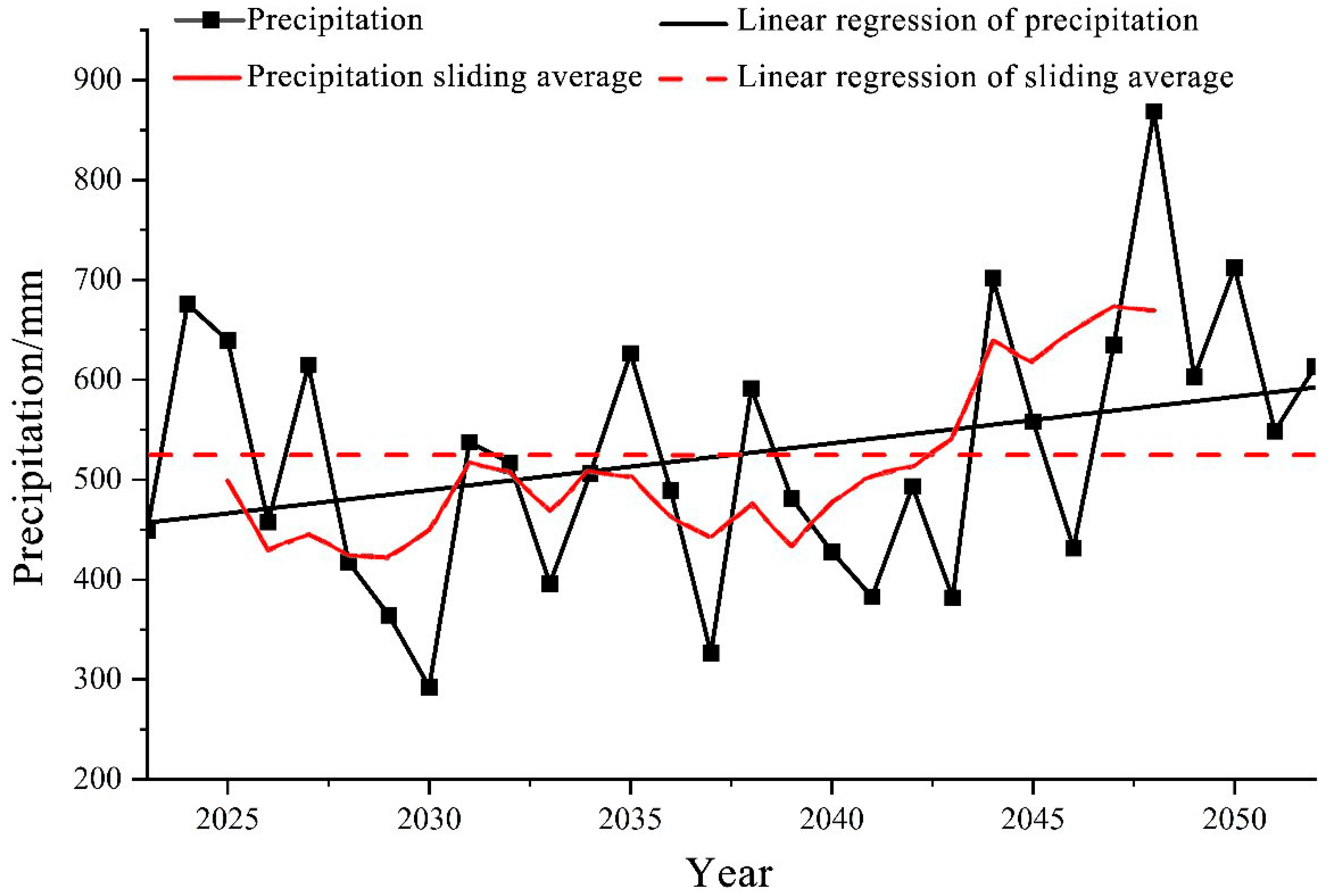
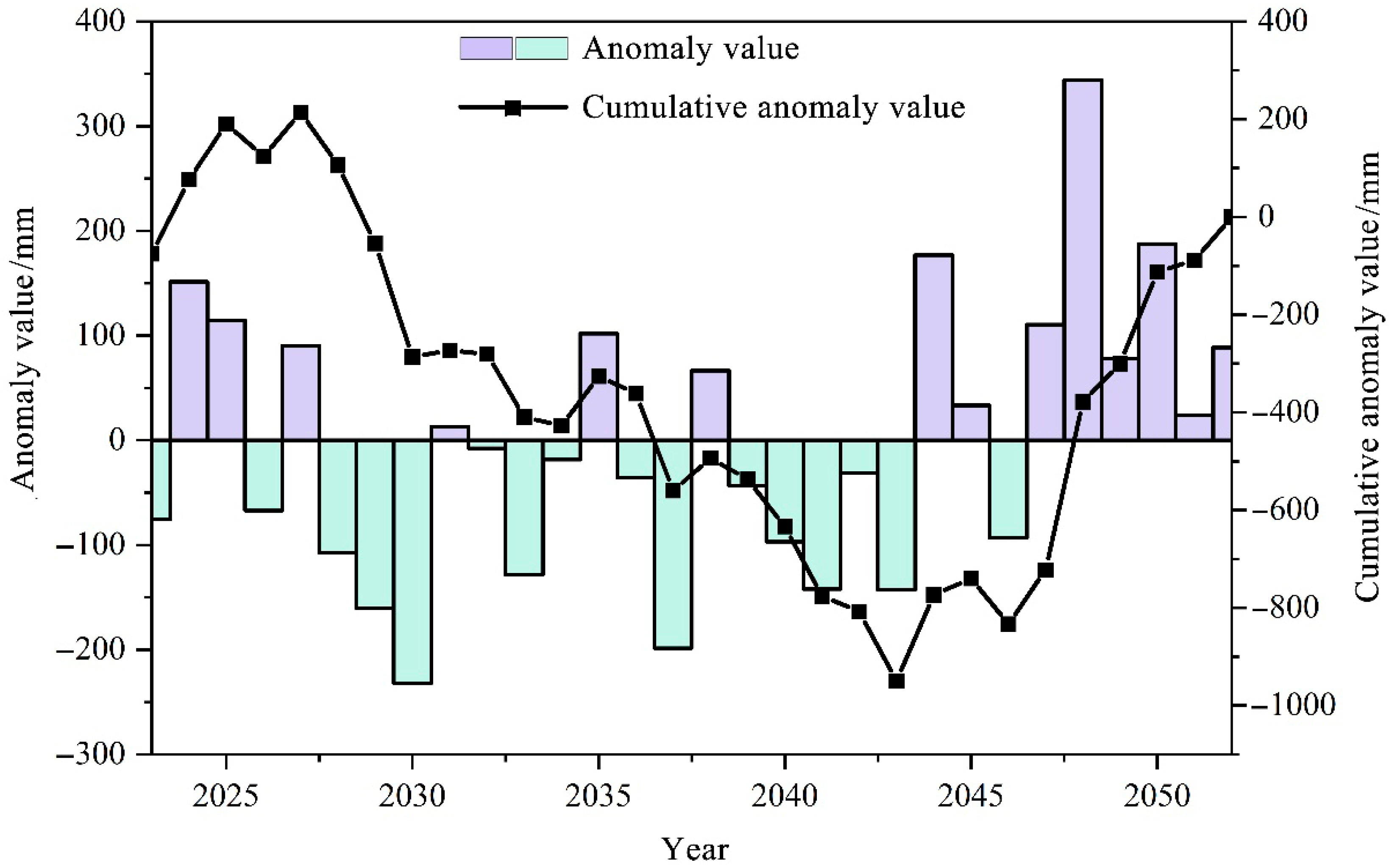
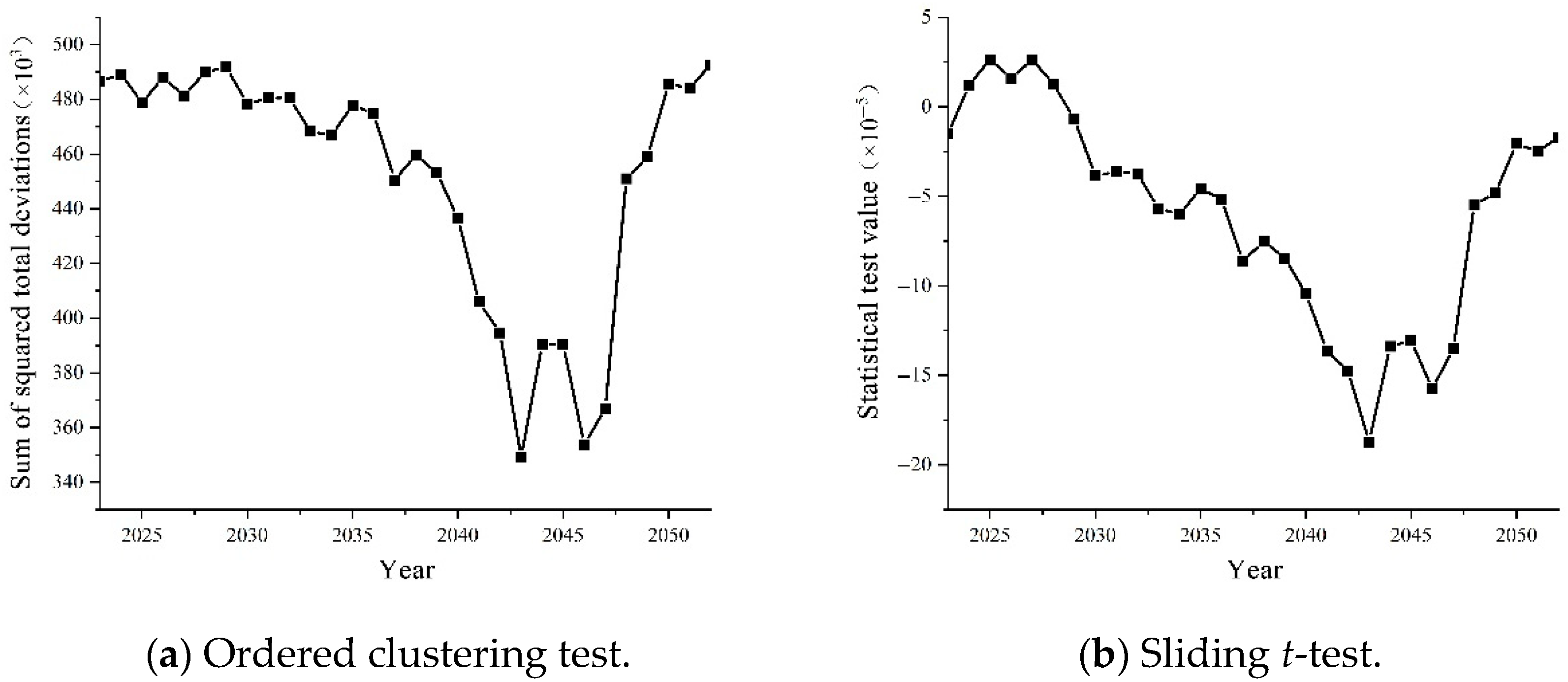
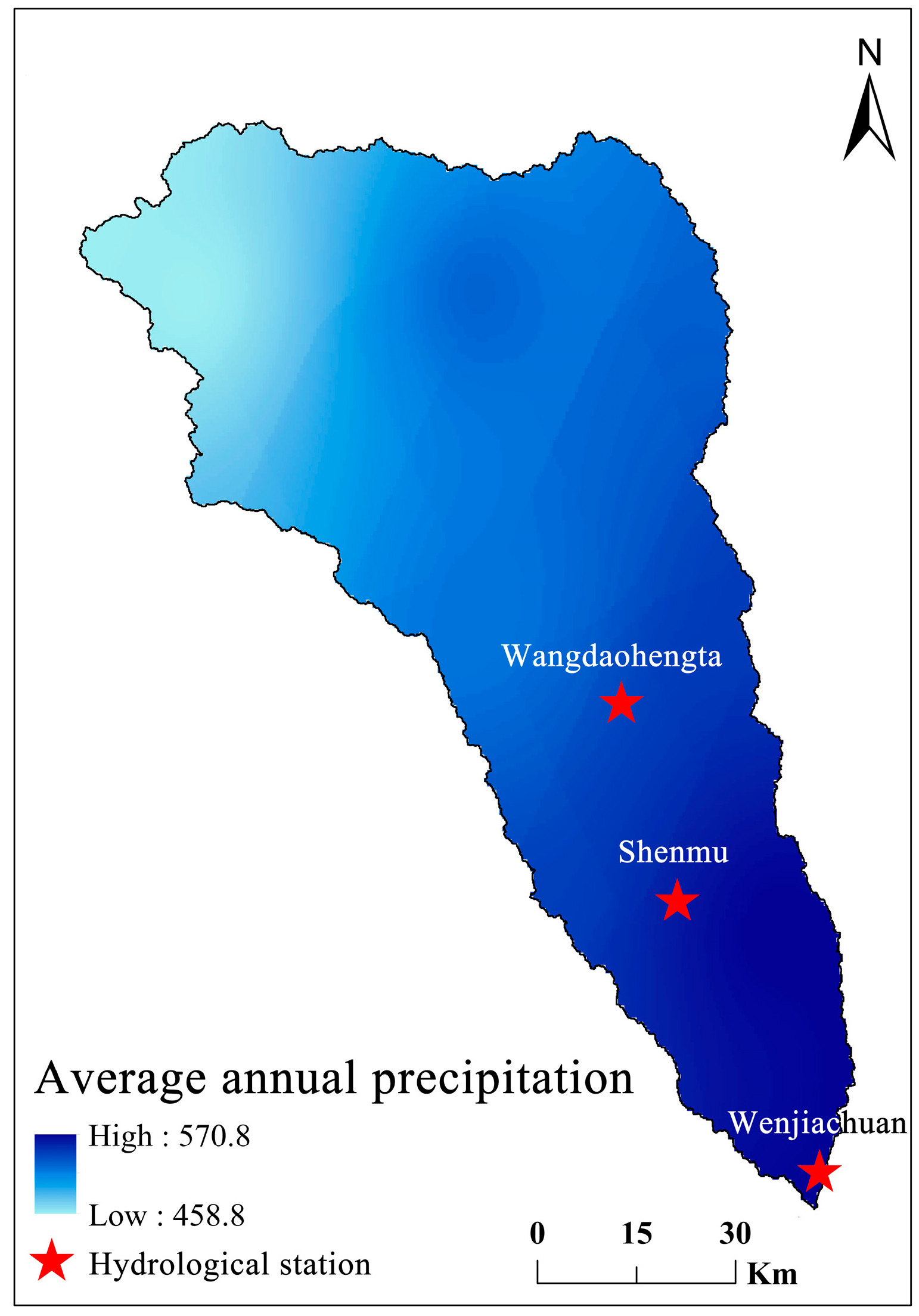
| Climate Model | Emission Scenario | Multi-Year Average Precipitation/mm | Absolute Error/mm | Percentage Bias/% |
|---|---|---|---|---|
| HadGEm3-RA | RCP4.5 | 513.10 | 6.73 | 1.33% |
| RCP8.5 | 511.65 | 5.28 | 1.04% | |
| YSU-RSM | RCP4.5 | 468.40 | 37.97 | 7.50% |
| RCP8.5 | 437.01 | 69.36 | 13.70% | |
| SNU-MM5 | RCP4.5 | 346.40 | 159.97 | 31.59% |
| RCP8.5 | 256.21 | 250.15 | 49.40% | |
| RegCM | RCP4.5 | 487.96 | 18.41 | 3.64% |
| RCP8.5 | 442.01 | 64.36 | 12.71% | |
| Observed Value | / | 506.37 | / | / |
| Month | Average Precipitation/mm | Proportion | Period | Average Precipitation/mm | Proportion |
|---|---|---|---|---|---|
| 1 | 2.38 | 0.53% | Spring | 64.68 | 14.53% |
| 2 | 3.84 | 0.86% | Summer | 269.8 | 60.62% |
| 3 | 10.15 | 2.28% | Autumn | 101.89 | 22.89% |
| 4 | 23.13 | 5.20% | Winter | 8.69 | 1.95% |
| 5 | 31.41 | 7.06% | Wet Season | 392.1159 | 88.16% |
| 6 | 50.72 | 11.4% | Dry Season | 52.6585 | 11.84% |
| 7 | 106.54 | 23.94% | |||
| 8 | 112.54 | 25.29% | |||
| 9 | 63.05 | 14.17% | |||
| 10 | 27.85 | 6.26% | |||
| 11 | 10.98 | 2.47% | |||
| 12 | 2.41 | 0.54% |
| Rainfall | Rainfall Type | Number of Days |
|---|---|---|
| <10 mm | Light rain | 22,661 |
| 10–25 mm | Moderate rain | 522 |
| 25–50 mm | Heavy rain | 153 |
| 50–100 mm | Torrential rain | 38 |
| 100–250 mm | Extreme torrential rain | 2 |
| >250 | Extreme heavy rain | 0 |
| Land-Use Types | 2015 | Total | ||||||
|---|---|---|---|---|---|---|---|---|
| Cropland | Forest Land | Grass Land | Watershed | Construction Land | Unused Land | |||
| 1980 | Cropland | 1344.66 | 66.00 | 197.70 | 5.49 | 105.10 | 4.67 | 1723.60 |
| Forest land | 3.02 | 312.67 | 37.09 | 2.27 | 26.40 | 1.53 | 382.99 | |
| Grass land | 94.99 | 74.40 | 4787.52 | 6.55 | 373.37 | 62.03 | 5398.84 | |
| Watershed | 3.73 | 8.14 | 19.71 | 194.06 | 28.88 | 7.33 | 261.86 | |
| Construction land | 0.39 | 0.20 | 2.59 | 0.09 | 77.71 | 0.10 | 81.09 | |
| Unused land | 21.63 | 15.43 | 393.41 | 2.47 | 38.93 | 389.66 | 861.52 | |
| Total | 1468.43 | 476.83 | 5438.01 | 210.93 | 650.39 | 465.32 | 8709.91 | |
Disclaimer/Publisher’s Note: The statements, opinions and data contained in all publications are solely those of the individual author(s) and contributor(s) and not of MDPI and/or the editor(s). MDPI and/or the editor(s) disclaim responsibility for any injury to people or property resulting from any ideas, methods, instructions or products referred to in the content. |
© 2025 by the authors. Licensee MDPI, Basel, Switzerland. This article is an open access article distributed under the terms and conditions of the Creative Commons Attribution (CC BY) license (https://creativecommons.org/licenses/by/4.0/).
Share and Cite
Liu, B.; Liu, Q.; Li, P.; Li, Z.; Guo, J.; Ma, J.; Wang, B.; Liu, X. Precipitation Changes and Future Trend Predictions in Typical Basin of the Loess Plateau, China. Sustainability 2025, 17, 6267. https://doi.org/10.3390/su17146267
Liu B, Liu Q, Li P, Li Z, Guo J, Ma J, Wang B, Liu X. Precipitation Changes and Future Trend Predictions in Typical Basin of the Loess Plateau, China. Sustainability. 2025; 17(14):6267. https://doi.org/10.3390/su17146267
Chicago/Turabian StyleLiu, Beilei, Qi Liu, Peng Li, Zhanbin Li, Jiajia Guo, Jianye Ma, Bo Wang, and Xiaohuang Liu. 2025. "Precipitation Changes and Future Trend Predictions in Typical Basin of the Loess Plateau, China" Sustainability 17, no. 14: 6267. https://doi.org/10.3390/su17146267
APA StyleLiu, B., Liu, Q., Li, P., Li, Z., Guo, J., Ma, J., Wang, B., & Liu, X. (2025). Precipitation Changes and Future Trend Predictions in Typical Basin of the Loess Plateau, China. Sustainability, 17(14), 6267. https://doi.org/10.3390/su17146267









